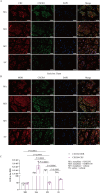Involvement of CXCL12/CXCR4 in CB2 receptor agonist-attenuated morphine tolerance in Walker 256 tumor-bearing rats with cancer pain
- PMID: 39696656
- PMCID: PMC11656961
- DOI: 10.1186/s40001-024-02207-6
Involvement of CXCL12/CXCR4 in CB2 receptor agonist-attenuated morphine tolerance in Walker 256 tumor-bearing rats with cancer pain
Abstract
While low-dose cannabinoid 2 (CB2) receptor agonists attenuate morphine tolerance in cancer pain models, chemokine ligand 12 (CXCL12)/chemokine receptor 4 (CXCR4) expression induces morphine tolerance. Whether CB2 receptor agonists attenuate morphine tolerance by modulating CXCL12/CXCR4 signaling or whether CXCL12/CXCR4 signaling affects the mu opioid receptor (MOR) in the development of morphine tolerance in cancer pain remains unclear. In this study, we investigated the attenuation of morphine tolerance by a non-analgesic dose of the CB2 receptor agonist AM1241, focusing specifically on the modulation of CXCL12/CXCR4 signaling and its effect on the MOR. Rats received intrathecal Walker 256 tumor cell implantations and were treated with morphine combined with the intrathecal injection of AM1241 or the CB2 receptor antagonists AM630 and AM1241, or a CXCL12-neutralizing antibody, exogenous CXCL12, or the CXCR4 antagonist AMD3100. Our results show that CXCL12 and CXCR4 levels increased significantly in morphine-tolerant rats and were reduced by AM1241 pretreatment, which was reversed by AM630. CXCL12/CXCR4 expression accelerated the development of morphine tolerance and downregulated MOR expression. CXCR4 colocalized with MOR and CB2. Therefore, a non-analgesic dose of AM1241 attenuated morphine tolerance via CXCL12/CXCR4 signaling, whereas CXCL12/CXCR4 signaling participated in the development of morphine tolerance, potentially by modulating MOR expression in Walker 256 tumor-bearing rats.
Keywords: Cancer pain; Cannabinoid 2; Chemokine ligand 12/chemokine receptor 4; Morphine tolerance; Mu opioid receptor.
© 2024. The Author(s).
Conflict of interest statement
Declarations. Animal ethics declaration: The study was performed in accordance with the International Association for the Study of Pain, and the protocol was authorized by the Animal Care and Use Committee of the Harbin Medical University Cancer Hospital (Harbin, China). The study was in accordance with ARRIVE guidelines. Competing interests: The authors declare no competing interests.
Figures






References
-
- Lin CP, Lu DH. Role of neuroinflammation in opioid tolerance: translational evidence from human-to-rodent studies. Adv Exp Med Biol. 2018;1099:125–39. - PubMed
-
- Sun M, Chang CL, Lu CY, Zhang J, Wu SY. Effect of opioids on cancer survival in patients with chronic pain: a propensity score-matched population-based cohort study. Br J Anaesth. 2022;128(4):708–17. 10.1016/j.bja.2021.12.051. - PubMed
-
- Roeckel LA, Le Coz GM, Gavériaux-Ruff C, Simonin F. Opioid-induced hyperalgesia: cellular and molecular mechanisms. Neuroscience. 2016;338:160–82. 10.1016/j.neuroscience.2016.06.029. - PubMed
MeSH terms
Substances
Grants and funding
LinkOut - more resources
Full Text Sources
Research Materials

